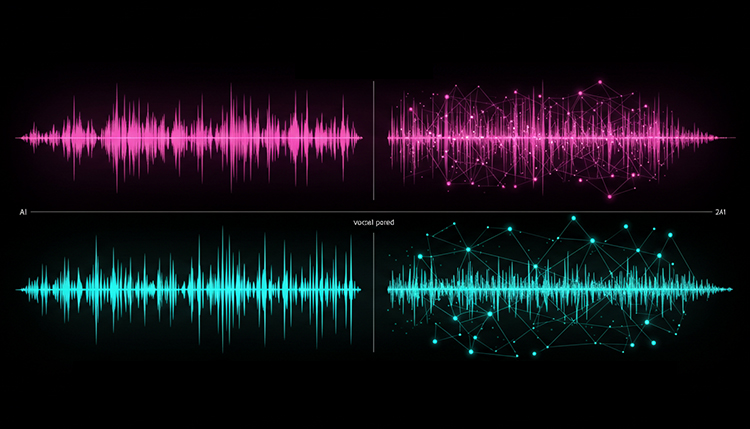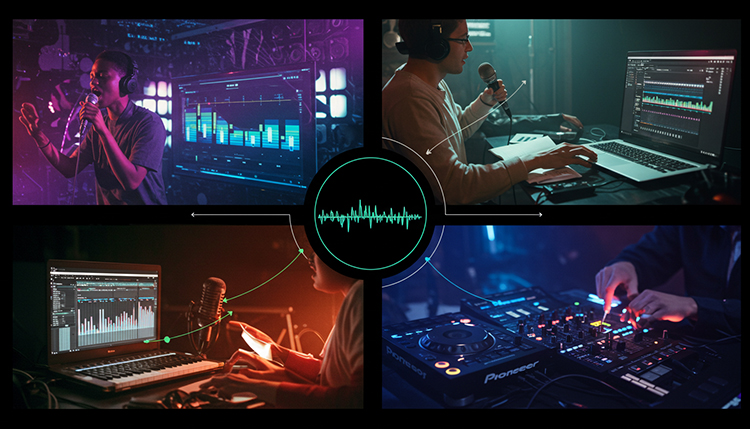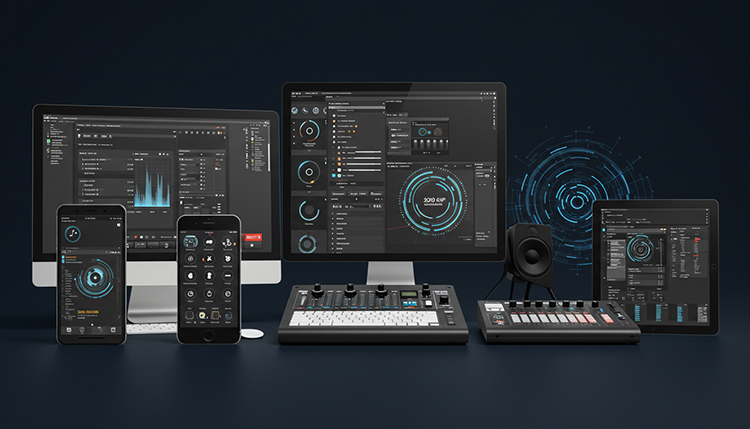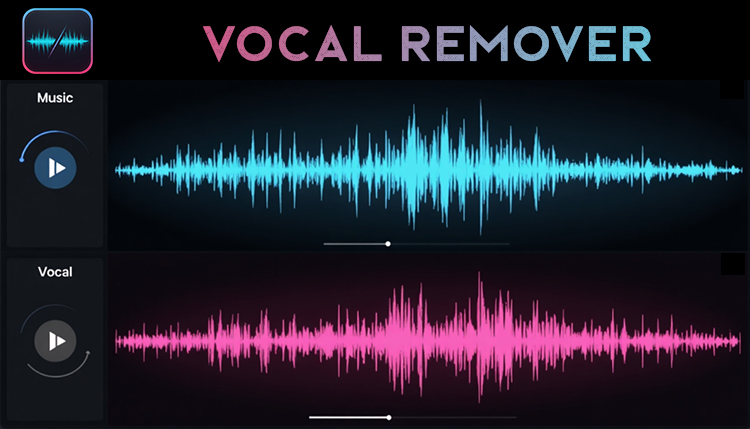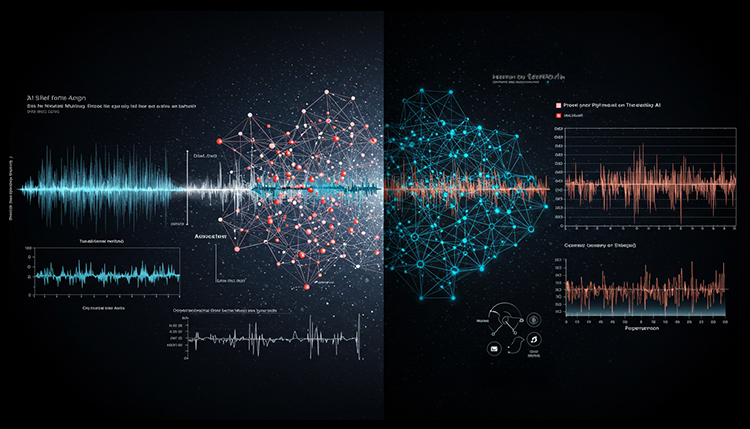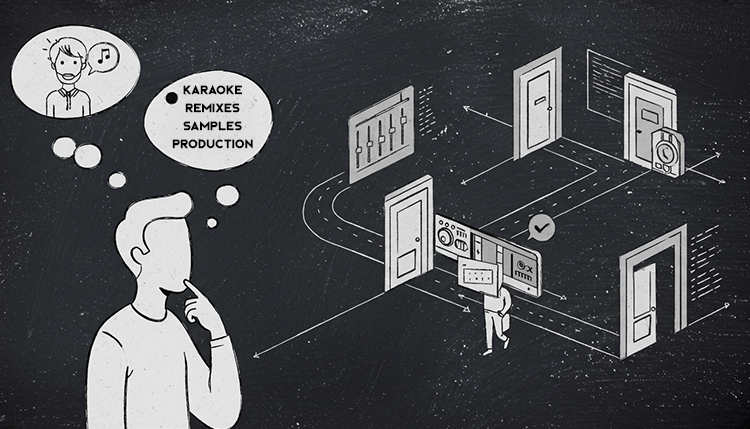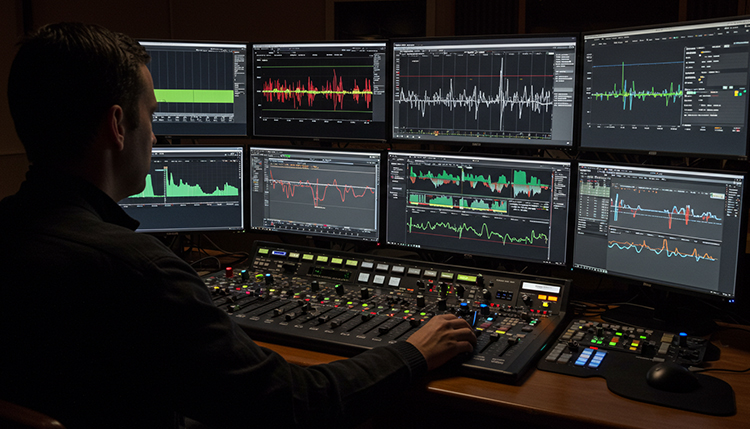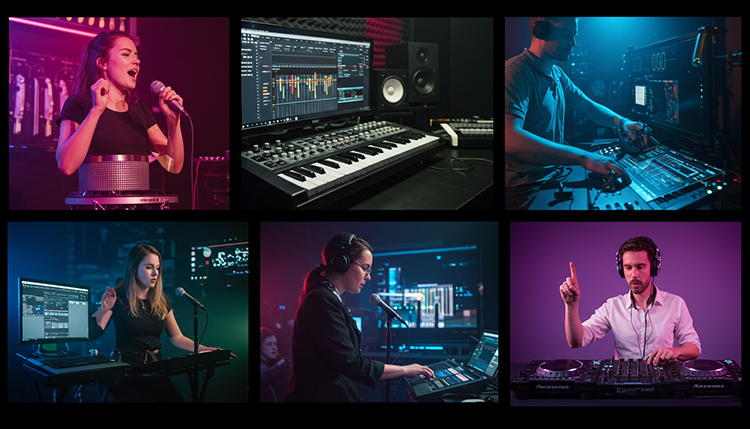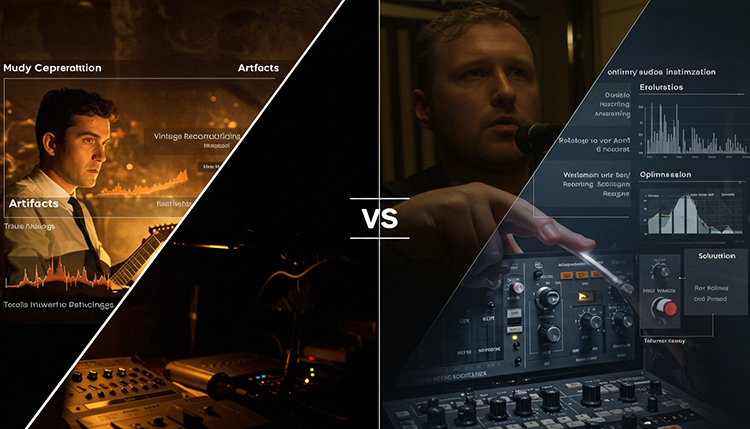Vocal Remover: Free Online App to Remove Vocals from Songs using AI
Ever been jamming to your favorite tune and thought, “Man, I wish I could sing this without the original vocalist stealing my thunder”? We’ve all been there!
Vocal removal technology has completely transformed how we interact with music, making it possible for anyone to separate vocals from instrumentals with just a few clicks. Gone are the days when you needed expensive studio equipment or technical know-how to create backing tracks or remixes.
Did you know that modern AI-powered vocal removers can achieve up to 90% separation accuracy on most commercial tracks? That’s mind-blowing when you think about it! What was once only possible in professional recording studios with specialized equipment is now available to anyone with an internet connection.
The ability to strip vocals from songs opens up a world of possibilities – from creating your own karaoke tracks to producing remixes or simply studying the instrumental composition of your favorite songs. Whether you’re a wannabe DJ, a karaoke enthusiast, or just someone who appreciates the intricacies of music production, vocal removal tools can be a game-changer.
Let’s dive deep into everything you need to know about vocal removers. We’ll explore how they work, the benefits they offer, and introduce you to our very own free AI-powered solution that’s revolutionizing the game.
So grab your headphones and get comfortable – you’re about to discover how to transform your music experience with the power of vocal removal technology!
What is a Vocal Remover and How Does it Work?
A vocal remover is essentially a digital tool that does exactly what its name suggests – it separates or removes the vocal track from a song, leaving you with just the instrumental backing. Pretty neat, right?
These handy tools have become increasingly sophisticated over the years, evolving from simple frequency filters to complex AI-powered systems that can identify and isolate specific elements of a song with impressive accuracy. The technology has come a long way since its early days!
At its most basic level, traditional vocal removal worked on a simple principle: in most commercial music, vocals are typically mixed in the center of the stereo field. This means the vocal track has equal volume in both the left and right channels of a stereo recording.
By using a technique called “phase cancellation,” early vocal removers would essentially subtract one stereo channel from the other, theoretically canceling out anything that was identical in both channels – primarily the vocals. Sounds clever, doesn’t it?
But there was a major catch with this old-school approach. This method often removed other center-panned instruments too, like bass drums and bass guitars, resulting in instrumentals that sounded thin and incomplete. Not exactly what you want for your karaoke night!
Modern vocal removers have thankfully moved well beyond these limitations. Today’s tools use sophisticated artificial intelligence and machine learning algorithms to analyze the acoustic properties of different sounds within a track.
These AI-powered vocal isolators can actually “learn” what vocal frequencies typically look like versus instrumental ones. They can recognize patterns in the audio that represent human voices and separate them from guitars, pianos, drums, and other instruments. That’s some serious tech wizardry!
The most advanced vocal extraction technology, like what powers our Vocal Remover Pro, uses deep neural networks trained on thousands of songs to understand the unique characteristics of vocals versus instruments. This approach is called “source separation” and it’s revolutionized the field of audio isolation.
Here’s a quick breakdown of how modern AI vocal removers typically work:
- Audio Analysis: The AI analyzes the full mix of the song, identifying different frequency ranges, timbres, and patterns
- Pattern Recognition: The system recognizes patterns that match vocal characteristics versus instrumental ones
- Separation Processing: Advanced algorithms separate the audio into different “stems” or component parts
- Output Generation: The system generates new audio files with isolated vocals, instrumentals, or other elements
One common misconception about vocal removers is that they can achieve 100% perfect separation. The truth is, even with cutting-edge AI technology, there are limitations based on how the original track was mixed and recorded.
For instance, if vocals have heavy effects like reverb or delay that blend into the instrumental parts, complete separation becomes trickier. Similarly, songs with complex vocal harmonies or unusual vocal processing might present challenges for even the best voice remover tools.
The quality of the original recording also plays a huge role in how well vocal suppression works. High-quality WAV files will generally yield better results than compressed MP3s, where some audio information has already been lost during compression.
Despite these challenges, the differences between basic and advanced vocal removal tools are striking. While basic tools might leave vocal artifacts or remove essential parts of the instrumental, advanced AI-based separators can produce remarkably clean results that would have seemed impossible just a few years ago.
So next time you’re wanting to belt out your favorite song without competing with the original artist, remember – there’s some seriously impressive technology working behind the scenes of that vocal remover you’re using!
Top Benefits of Using a Vocal Remover
Let’s face it – vocal removers are pretty much magic for music lovers. They unlock possibilities that were once only available to professional studios with expensive equipment.
Creating custom karaoke tracks tops the list of benefits for many users. There’s nothing quite like hosting a karaoke night with tracks that aren’t available on traditional karaoke platforms. Your friends will be seriously impressed when you pull up that obscure indie track everyone loves!
With a quality vocal remover, you can transform literally any song in your library into a karaoke version. This means unlimited options for your next singing session, whether you’re practicing alone in your shower or hosting the neighborhood karaoke championship.
The applications go way beyond just casual singing fun though. For aspiring vocalists and music students, practicing with original backing tracks provides an authentic experience that karaoke versions often lack.
You can actually sing along with the exact instrumentation from your favorite artists, helping you develop timing, pitch control, and performance skills in a realistic context. Talk about leveling up your practice sessions!
For the remix enthusiasts and budding producers out there, vocal removers are an absolute game-changer. They allow you to isolate instrumental tracks that can serve as the foundation for entirely new creations.
Imagine taking the instrumental from a classic rock song and transforming it into a dance track, or combining elements from multiple separated songs into something completely unique. The creative possibilities are literally endless!
Here’s where things get really interesting for the music nerds (and we mean that in the best way possible). Using a vocal isolation app allows you to study the vocal techniques of your favorite singers with incredible clarity.
You can isolate just the vocals to analyze how they phrase certain lines, their breathing techniques, vibrato control, or how they navigate difficult passages. This kind of detailed study was previously only possible with access to original studio multitracks – which are rarely available to the public.
The benefits extend into some surprisingly practical areas too:
- Language learning – Remove vocals from foreign language songs to practice pronunciation with the instrumental, then compare to the original
- Music education – Isolate specific instruments to better understand arrangement and composition techniques
- Podcast and video creation – Extract music beds without vocals for background music that won’t compete with narration
- Sample creation – Generate clean instrumental sections for sampling in new music production
- Performance backing tracks – Create professional-quality backing tracks for live performances
Professional music producers have been known to use vocal removal technology as part of their workflow too. Sometimes it’s easier to extract elements from an existing track than to recreate them from scratch, especially when working with reference tracks or trying to capture a specific sound.
For DJs, the ability to create extended intros, outros, or vocal-free sections of popular tracks provides more flexibility for creative mixing and seamless transitions between songs. This can take a good DJ set and make it absolutely fire!
Even casual listeners can benefit from vocal removal technology. Have you ever wanted to appreciate the intricate instrumental work in your favorite songs without vocals dominating? Separating the tracks lets you experience familiar music in entirely new ways.
You might discover amazing guitar work, subtle keyboard parts, or rhythm section magic that was previously hiding behind powerful vocals. It’s like getting backstage access to the composition itself!
The democratization of this technology means that what was once reserved for professional studios is now available to anyone with an internet connection. That’s pretty revolutionary when you think about it.
Whether you’re a serious musician, a casual karaoke fan, or just someone who loves to explore music from different angles, vocal removal tools offer something valuable for almost everyone.
Types of Vocal Removers Available in 2025
The vocal remover landscape has exploded with options in recent years, giving users plenty of choices depending on their needs, technical skills, and how deep they want to dive into audio manipulation.
Desktop software applications remain popular among serious users who need consistent, high-quality results without internet dependency. These programs typically install directly on your computer and offer more processing power and advanced features than their online counterparts.
The big advantage of desktop vocal cancellation technology is processing power. Your computer can handle more complex algorithms than what’s typically possible in a browser, potentially leading to cleaner separation results.
Many desktop options also integrate directly with popular Digital Audio Workstations (DAWs) like Ableton, FL Studio, or Logic Pro, making them seamless additions to an existing music production workflow. This integration is clutch for producers who need vocal removal as just one step in a larger creative process.
However, desktop apps come with their own drawbacks. They often carry a higher price tag than online alternatives, require installation and updates, and may have steeper learning curves. Plus, they’re typically tied to the specific computer they’re installed on, limiting flexibility.
Online web-based vocal removers have seen the biggest growth in recent years, and for good reason. These tools run in your browser, requiring no downloads or installation – just upload your track and let the server-side processing do the heavy lifting.
The accessibility factor here is huge. You can use these tools from any device with an internet connection, whether it’s your laptop, tablet, or even your phone in a pinch. No need to worry about system requirements or compatible operating systems!
Most online vocal isolator tools feature simple, intuitive interfaces designed for users of all technical levels. This democratizes the technology, making it accessible even to those with zero audio engineering experience.
The downside? Online tools are dependent on your internet connection and upload/download speeds. If you’re working with large audio files or have a spotty connection, this could become frustrating. And browser-based tools may have limitations on file sizes or processing capabilities compared to their desktop counterparts.
Mobile apps for vocal removal have carved out their own niche, perfect for on-the-go creativity or quick projects. These apps bring vocal removal technology right to your pocket, allowing for spontaneous music creation or practice anywhere.
The convenience factor can’t be overstated – imagine being able to quickly create a backing track while on the bus to your band practice or isolating vocals to study singing techniques during your lunch break. That’s pretty sweet!
Most mobile vocal remover apps feature simplified interfaces optimized for touchscreens, making them approachable for casual users. However, this simplicity often comes at the cost of advanced features or perfect separation quality.
The limited processing power of mobile devices compared to desktops also means these apps might not achieve the same level of separation quality for complex tracks. But for quick projects or basic needs, they’re incredibly handy.
For professional audio engineers and serious producers, DAW plugins represent the high-end option in the vocal remover ecosystem. These specialized tools integrate directly into professional audio workstations, becoming part of a comprehensive production environment.
The primary advantage here is workflow integration – there’s no need to export audio, process it in a separate application, and then reimport. Everything happens within your production environment, saving valuable time and maintaining project organization.
DAW plugins typically offer the most granular control over the separation process, allowing for fine-tuning that other options might not provide. This level of control can be crucial for professional applications where quality standards are exceptionally high.
Here’s a quick breakdown of the main types you’ll encounter:
- Desktop Software: High processing power, advanced features, one-time purchase, steeper learning curve
- Web Applications: Accessible anywhere, no installation required, subscription-based, limited by internet connection
- Mobile Apps: Ultimate convenience, simplified interfaces, lower processing power, great for quick projects
- DAW Plugins: Professional integration, highest control, typically most expensive, requires existing DAW knowledge
When it comes to free versus premium options, the gap has narrowed significantly in recent years. Free tools like our Vocal Remover Pro now utilize advanced AI technology that rivals many paid options, though premium tools might still offer advantages in terms of processing speed, additional features, or batch processing capabilities.
The most significant difference often comes down to usage restrictions rather than core technology – free tools might limit file sizes, number of conversions, or add watermarks, while premium options remove these limitations.
For casual users, the free options available in 2025 are honestly mind-blowing compared to what was available just a few years ago. The democratization of AI has truly revolutionized what’s possible without opening your wallet.
Introducing Vocal Remover Pro: Our Free AI-Powered Solution
Say hello to Vocal Remover Pro – the game-changing tool that’s making professional-grade vocal removal accessible to everyone, completely free of charge. No catches, no hidden fees, just powerful AI technology at your fingertips.
This isn’t your grandpa’s vocal remover (not that he had one, but you get the point). Vocal Remover Pro harnesses cutting-edge artificial intelligence to deliver separation results that would have seemed like science fiction just a few years ago.
At the heart of our system is Spleeter, a revolutionary AI-based source separation library developed by music streaming giant Deezer’s research team. This powerful technology has been trained on thousands of songs to recognize and isolate different components of a music track with remarkable accuracy.
Using Vocal Remover Pro couldn’t be simpler. The whole process is designed to be intuitive even if you’ve never used audio software before.
First, you’ll upload your audio file by either dragging and dropping it into the designated area or clicking to browse your files. The system supports all common audio formats including MP3, WAV, AAC, and FLAC, so you won’t need to convert your files beforehand.
Once your file is uploaded, the AI processing magic begins. This is where Spleeter analyzes your audio track, identifying the unique acoustic fingerprints of vocals versus instruments, and separates them into distinct stems.
What makes Vocal Remover Pro special is the flexibility it offers through multiple separation models:
- 2-stems model: This option splits your track into vocals and accompaniment – perfect for creating quick karaoke tracks or isolating vocals for study
- 4-stems model: Takes separation further by dividing your track into vocals, drums, bass, and other instruments – ideal for remixing or more detailed music analysis
- 5-stems model: The most comprehensive option, separating into vocals, drums, bass, piano, and other instruments – giving you maximum control for advanced projects
You can easily select your preferred model in the Settings section before processing. Not sure which to choose? Start with the 2-stems model for basic vocal removal, or experiment with the more detailed models if you need isolated instrument tracks.
After processing (which typically takes just a minute or two depending on file length), you’ll receive each separated stem as an individual audio file. You can preview these directly in your browser – super convenient for checking the results before downloading.
The separation quality is seriously impressive. While no AI system can achieve 100% perfect separation (especially for heavily processed commercial tracks), Vocal Remover Pro consistently delivers clean, usable stems that sound natural and preserve the original audio quality.
What sets our tool apart from other free options? For starters, there are no artificial limitations on file size or quality that you often find with other free tools. We don’t compress your output files or add annoying watermarks either.
The multi-stem options also put Vocal Remover Pro in a league above basic vocal removers that only offer simple vocal/instrumental separation. Having access to isolated drums, bass, and other instrument tracks opens up creative possibilities that basic tools simply can’t match.
Users have been putting Vocal Remover Pro to work in amazingly creative ways. DJs are using it to create custom mashups and remixes, combining instrumental tracks from one song with vocals from another. Music students are isolating instrument parts to learn complex passages. Karaoke enthusiasts are building massive libraries of backing tracks from their favorite songs.
To get the best results from Vocal Remover Pro, keep these pro tips in mind:
- Use high-quality source files whenever possible – WAV or lossless formats will yield better results than compressed MP3s
- Simple mixes separate better than complex ones – a track with fewer instruments competing in the same frequency range as the vocals will separate more cleanly
- Try different models if you’re not satisfied with the results – sometimes the 4-stem model works better than 2-stem for certain genres
- Experiment with post-processing – slight EQ adjustments to the separated tracks can sometimes improve the final result
Whether you’re creating karaoke tracks, producing remixes, or just curious about the instrumental composition of your favorite songs, Vocal Remover Pro provides studio-quality results without the studio price tag.
The best part? We’re constantly improving the AI models based on user feedback and advancements in machine learning technology, so the results will only get better over time. That’s what we call a win-win situation!
Ready to transform your music experience? Give Vocal Remover Pro a try today and join thousands of users who are already unlocking new creative possibilities with our free AI-powered tool.
Understanding AI in Vocal Removal Technology
The AI revolution has completely transformed how we approach vocal removal, taking it from a crude approximation to an almost magical level of precision. It’s honestly kind of mind-blowing!
Traditional vocal removal methods relied primarily on a technique called phase cancellation. This approach worked on the principle that in most commercial recordings, vocals are positioned in the “center” of the stereo field.
By inverting one stereo channel and combining it with the other, anything that appeared identically in both channels (typically the vocals) would theoretically cancel out. Sounds clever in theory, right?
Unfortunately, this method had major limitations. It often removed other center-panned elements like kick drums and bass, while leaving behind vocal reverb and artifacts. The results were frequently described as “karaoke quality” – and not in a complimentary way!
Enter neural networks and deep learning, which have fundamentally changed the game. Modern AI vocal separators like Spleeter don’t just rely on the stereo positioning of sounds – they actually “understand” the acoustic characteristics that distinguish voices from instruments.
These systems are trained on thousands of hours of music, learning to recognize the unique spectral fingerprints of different sound sources. The neural networks essentially build internal models of what vocals, drums, bass, and other instruments typically “look like” in audio form.
When you feed a song into an AI vocal extractor, it analyzes the audio using these learned patterns to identify and separate different elements with remarkable accuracy. It’s basically like having a super-intelligent audio engineer that can instantly recognize and isolate different parts of a mix.
Spleeter, which powers our Vocal Remover Pro, represents one of the most advanced implementations of this technology. Developed by researchers at music streaming service Deezer, it uses a U-Net convolutional neural network architecture specifically optimized for audio source separation.
The difference between traditional and AI-based approaches is night and day. Traditional methods might reduce vocals by 6-12dB at best, while leaving significant artifacts. AI methods can achieve 20+ dB of separation, often producing instrumentals clean enough for professional use.
Here’s where things get really exciting – we’re still in the early days of this technology! Current research directions in AI vocal separation include:
- Cross-adaptive neural networks that can better handle unusual vocal processing or exotic instruments
- Real-time separation capabilities for live applications and streaming
- Enhanced preservation of spatial effects like reverb and delay
- Voice-specific training that can target particular vocal timbres or styles
- Multi-language optimization to better handle the unique characteristics of different languages
As these technologies mature, we can expect even more impressive results in the future. Imagine being able to not just remove vocals, but selectively isolate specific singers in a group, or separate backing vocals from lead vocals with perfect clarity!
The applications extend far beyond just creating karaoke tracks. Music archivists are using these tools to restore and remaster historical recordings. Film sound designers are employing them to repurpose audio elements for new contexts. Music educators are creating teaching materials that focus on specific aspects of complex arrangements.
Of course, with great power comes great responsibility. The ethics of audio separation technology deserve consideration too. The ability to manipulate recorded music with such precision raises questions about intellectual property, artistic intent, and potential misuse.
Most legitimate applications fall under fair use or personal enjoyment, but as separation quality improves, the line between transformative use and reproduction becomes blurrier. This is why many developers (including us) encourage users to respect copyright and use separated tracks responsibly.
Some key ethical guidelines when using AI vocal removal include:
- Respecting copyright laws and not distributing separated tracks commercially without proper licensing
- Giving proper credit to original artists when sharing derivative works
- Obtaining permission when using separated elements in public performances
- Being transparent about the use of separation technology in derivative works
- Avoiding misleading applications that could misrepresent an artist’s work
Despite these considerations, the overwhelmingly positive potential of AI audio separation technology is undeniable. It’s democratizing access to tools that were once available only to industry professionals, enabling creativity and musical exploration for everyone.
The neural net audio processing revolution isn’t slowing down anytime soon. As algorithms improve and training data expands, we can expect even more impressive separation quality in the coming years.
Whether you’re a casual music fan wanting to sing along without competing with the original vocalist, or a serious producer looking to remix and reimagine existing works, AI vocal removal technology offers possibilities that were unimaginable just a decade ago. That’s something worth getting excited about!
How to Choose the Right Vocal Remover for Your Needs
Picking the perfect vocal remover isn’t just about grabbing the first free option you find online. Like choosing the right pair of headphones or microphone, it’s about matching the tool to your specific needs and goals.
The first question to ask yourself is: what exactly am I trying to accomplish? Different goals require different tools, and being clear about your end game will save you tons of time and potential frustration.
Are you a karaoke enthusiast looking to create backing tracks for your weekend singing sessions? A simple vocal remover with 2-stem separation might be all you need. The focus here is on getting clean instrumentals rather than perfect vocal isolation.
Maybe you’re a remix producer wanting to extract specific elements from tracks to create something new. In this case, you’ll want a more sophisticated tool with multi-stem separation capabilities that can isolate not just vocals, but drums, bass, and other instruments too.
For professional music educators or vocal coaches, the quality of vocal isolation becomes paramount. You’ll want a tool that preserves the nuances and details of the original vocal performance without artifacts or distortion.
Audio quality should be at the top of your assessment criteria list. Even the most feature-packed vocal remover won’t be useful if it produces results that sound artificial or processed.
Look for tools that maintain the natural sound and feel of the original recording. Good separation doesn’t just remove vocals – it preserves the integrity and character of both the isolated vocals and the remaining instrumental.
When evaluating separation quality, pay special attention to how the tool handles:
- Vocal reverb and effects – Does it remove just the dry vocal or the associated reverb too?
- Transients and attack – Do drums and percussive elements maintain their punch?
- Stereo imaging – Does the instrumental still have appropriate width and depth?
- Frequency balance – Are all frequencies represented naturally in the separated tracks?
- Artifacts – Are there any strange digital artifacts or “watery” sounds in the results?
Ease of use is another crucial factor, especially if you’re not technically inclined. Some vocal removers require significant audio engineering knowledge to get good results, while others are designed with simplicity in mind.
Look for tools with intuitive interfaces that don’t overwhelm you with technical parameters unless you specifically need that level of control. The best tools strike a balance between accessibility and flexibility, with basic options for beginners and advanced settings for those who want to fine-tune the results.
Feature set is where vocal removers really start to differentiate themselves. Beyond basic vocal/instrumental separation, consider whether you need:
- Multi-stem separation – Isolation of drums, bass, vocals, and other instruments as separate tracks
- Batch processing – The ability to process multiple files at once
- Adjustable separation parameters – Control over how aggressively the algorithm separates elements
- Format support – Compatibility with various audio formats (MP3, WAV, FLAC, etc.)
- Preview capabilities – The ability to hear results before committing to processing
- Post-processing options – Built-in EQ, compression, or other tools to enhance separated tracks
Processing speed and efficiency matter too, especially if you’re working with multiple or lengthy tracks. Some tools process audio in real-time or faster, while others might take several minutes to separate even short clips.
If you’re on a tight deadline or plan to process many files, a faster tool will save you significant time in the long run. Just remember that there’s often a trade-off between speed and quality – the most accurate separation algorithms typically take longer to run.
Budget considerations naturally come into play for many users. While our Vocal Remover Pro offers professional-quality results for free, other tools on the market range from free with limitations to subscription models to one-time purchases of several hundred dollars.
When assessing the value proposition of paid options, consider not just the upfront cost but also:
- Usage restrictions – Are there limits on file size, number of conversions, etc.?
- Update policy – Will you receive algorithm improvements and new features over time?
- Support options – Is technical help available if you encounter issues?
- Additional functionality – Does the tool offer valuable features beyond basic separation?
Finally, compatibility with your existing workflow is worth considering. If you already use specific music production software, look for vocal removers that integrate well with your setup, either as plugins or through compatible file formats.
Before committing to any vocal removal solution, try asking yourself these key questions:
- How important is separation quality versus convenience for my needs?
- Do I need to isolate multiple elements or just remove vocals?
- How frequently will I be using this tool?
- What’s my technical skill level with audio processing?
- Do I need a solution that works offline or is web-based acceptable?
- Will my needs likely expand in the future, requiring more advanced features?
Being honest about these questions will help steer you toward a vocal remover that truly meets your needs rather than one that simply boasts the most features or the flashiest marketing.
For most users in 2025, AI-powered options like our Vocal Remover Pro hit the sweet spot of excellent quality, intuitive operation, and flexible capabilities without breaking the bank. The neural network approach delivers results that were simply impossible with traditional technology, making this an exciting time for anyone interested in audio separation!
Advanced Tips for Perfect Vocal Removal
Getting good results with vocal removal is one thing, but achieving truly professional-quality separation requires a bit more finesse. Let’s dive into some advanced techniques that can take your vocal extraction game to the next level!
Preparation is half the battle when it comes to achieving stellar separation results. The quality of your source material plays a huge role in how clean your final separated tracks will be.
Always start with the highest quality version of the song available to you. Lossless formats like WAV or FLAC preserve all the audio information from the original recording, giving the AI more data to work with during separation.
If you only have access to compressed formats like MP3, aim for the highest bitrate possible – 320kbps will yield significantly better results than 128kbps. Every little bit of audio quality helps the algorithm make better decisions about what’s a vocal and what’s not!
Before uploading your file for processing, take a quick listen through good headphones to identify any potential challenges. Songs with heavily processed vocals, extensive vocal harmonies, or unusual effects might require special handling or alternative separation approaches.
It’s also worth trimming silence from the beginning and end of your track before processing. This not only reduces processing time but can help the AI focus its “attention” on the actual audio content rather than silent passages.
Different music genres respond differently to vocal removal algorithms due to their typical mixing characteristics. Understanding these differences can help you adjust settings appropriately:
- Pop/Rock: Generally well-balanced mixes with clear separation between elements – standard settings usually work well
- Hip-Hop/Rap: Often feature vocals very prominently in the center – may require stronger separation settings
- Electronic/Dance: Heavy processing and effects can blur the line between vocals and instruments – experiment with different stem models
- Classical/Orchestral: Complex instrumental textures can be challenging – focus on preserving instrumental detail
- Acoustic/Folk: Simpler arrangements often separate very cleanly – gentle settings to preserve natural sound
In Vocal Remover Pro, you can adapt to these genre differences by selecting the appropriate stem model. For genres with simpler arrangements, the 2-stem model often works perfectly. For complex mixes with many competing elements, the 4-stem or 5-stem models can provide better isolation.
The recording era also impacts separation results. Modern digital recordings (post-2000s) typically separate more cleanly than older analog recordings from the 70s or 80s. Vintage recordings may require additional post-processing to achieve satisfactory results.
Speaking of post-processing, this is where the magic really happens for professional-quality results. While AI separation is impressive on its own, a few targeted adjustments to the separated tracks can elevate them from “good” to “great.”
For instrumental tracks with some vocal artifacts remaining, try these techniques:
- Surgical EQ: Apply narrow EQ cuts in the 2-5kHz range (where vocals typically sit) to minimize remaining vocal traces
- Gentle reverb: A touch of reverb can help mask minor artifacts while adding spatial depth to the instrumental
- Mid/side processing: Since vocals are typically centered, reducing the mid channel slightly can minimize residual vocal content
- Multiband expansion: Setting an expander to reduce volume when it detects frequencies common to vocals can clean up stubborn spots
For isolated vocal tracks that need cleaning:
- De-essing: Reduce harsh sibilance (s and t sounds) that may become more pronounced in isolation
- Gentle compression: Smooth out volume inconsistencies that become more noticeable without the backing track
- EQ enhancement: A slight boost around 100Hz can add warmth, while a gentle lift around 5-8kHz can add clarity
- Reverb matching: If the original vocal had reverb, try to match it on your isolated vocal for a natural sound
When full separation isn’t giving perfect results, don’t be afraid to get creative with combined approaches. Some professional engineers use multiple different vocal removers on the same track and then blend the results to get the best of each algorithm.
Another hybrid approach is to use frequency-selective processing – perhaps using AI separation for most of the frequency spectrum, but applying traditional phase cancellation techniques just for troublesome frequency ranges.
Common challenges in vocal removal can usually be overcome with the right approach:
- Problem: Percussion elements getting removed along with vocals
- Solution: Use the 4-stem or 5-stem model to preserve drums separately
- Problem: Loss of stereo width in instrumental tracks
- Solution: Apply stereo enhancement to the separated instrumental or try a different separation model
- Problem: “Pumping” or “watery” artifacts in separated tracks
- Solution: Try processing with a different AI model or apply gentle noise reduction
- Problem: Backing vocals not fully removed
- Solution: For songs with complex vocal arrangements, try multiple passes of separation or focus on using the isolated instrumental
- Problem: Poor results with heavily produced electronic vocals
- Solution: These can be challenging for any algorithm – try extracting just the instrumental and accepting some vocal remnants
Remember that expectations should be realistic – even the most advanced AI separation technology has limitations. The goal isn’t always 100% perfect separation (which is often impossible from mixed tracks) but rather achieving results that are clean enough for your specific purpose.
With the right preparation, appropriate settings, and thoughtful post-processing, today’s AI vocal removers can produce separation quality that would have seemed impossible just a few years ago. The technology continues to improve rapidly, with each new algorithm generation bringing us closer to that elusive perfect separation!
Creative Projects Using Vocal Removal Technology
Now that you’ve got the technical know-how under your belt, let’s explore some of the awesome creative projects you can tackle with vocal removal technology. The possibilities are seriously endless!
Creating professional-quality karaoke tracks is probably the most obvious application, but even this can be taken to the next level with the right approach. Don’t just settle for removing vocals – craft an experience!
Start by selecting songs that will separate well – modern pop productions with clear, centered vocals typically yield the best results. Run them through Vocal Remover Pro using the 2-stem model for a clean instrumental.
After separation, don’t just call it done! Take a few minutes to enhance your karaoke track with some simple but effective touches:
- Gentle mastering: Apply light compression and EQ to make the instrumental sound full and balanced
- Intro/outro editing: Extend intros to give singers time to prepare
- Dynamic adjustments: Bring up quiet instrumental sections that might have been balanced against louder vocals
- Cue markers: Add visual cues or countdowns if your playback system supports them
- Backing vocal ghosts: Consider leaving in very faint traces of the original vocals for challenging sections
These small details elevate your karaoke tracks from basic to professional-grade, impressing your friends at the next sing-along session. Who doesn’t want to be the karaoke hero?
Remixing is where vocal removal technology really shines as a creative tool. The ability to isolate clean vocals or specific instrument groups opens up mind-blowing possibilities for music producers.
Try this creative exercise: Take vocals from a ballad and place them over an instrumental from a completely different genre. Slow pop vocals over a drum and bass beat? Country vocals over a trap instrumental? The genre-bending possibilities are limited only by your imagination!
For more advanced remix projects, use the 4-stem or 5-stem separation to isolate not just vocals but individual instrument groups. This allows for surgical remixing – perhaps keeping the original bass line but replacing everything else, or preserving just the drum groove while reconstructing the rest of the arrangement.
Tempo and key matching become important here. Tools like Mixed In Key can help identify the original key, while various DAW functions can help adjust tempo and pitch to create natural-sounding combinations. The results can be absolutely fire!
Music education and practice applications offer another valuable use case for vocal removal technology. For instrumental students, being able to remove or isolate specific instruments creates powerful learning opportunities.
A guitar student can extract the vocal melody from a favorite song and try to play it on their instrument, developing their ear training and melodic sensibilities. A drum student can isolate just the drums from a recording to study the pattern in detail, then practice along with the original track minus drums.
For vocal students and singers, the benefits are equally impressive. Practicing with the actual instrumental tracks from commercial recordings provides a much more authentic experience than generic backing tracks. The nuanced dynamics and production details help develop true performance skills.
Isolating just the vocals from favorite artists allows for detailed study of vocal techniques too. Want to understand how your favorite singer navigates a difficult passage or achieves a particular effect? Isolated vocals make it possible to hear every breath, every subtle inflection with crystal clarity.
Here are some specific music education applications worth trying:
- Transcription practice: Isolate specific instruments to create more accurate sheet music or tablature
- Articulation study: Focus on how professional vocalists phrase and articulate lyrics
- Rhythmic analysis: Extract drum tracks to study complex rhythmic patterns
- Harmony practice: Remove lead vocals but keep backing harmonies to practice singing lead
- Instrumental spotting: Identify hard-to-hear instrumental parts in dense mixes
Film and video production can benefit tremendously from vocal removal technology too. Need background music for your YouTube channel or independent film project? Starting with commercially available instrumentals can be limiting, but creating your own from existing tracks opens up endless possibilities.
Using Vocal Remover Pro, you can extract clean instrumentals from songs that match the exact mood you’re looking for. The instrumental can then be edited to fit your visual timeline perfectly, creating custom music beds that elevate your production value.
For dialogue replacement or voice-over work, you might need to extract clean dialogue from scenes with background music. Source separation technology can help isolate spoken word from musical elements, making ADR (Automated Dialogue Replacement) work much easier in challenging audio environments.
Building a sample library is another creative project where vocal removers truly shine. The ability to extract clean instrument loops and sounds from existing recordings is like having access to thousands of sample packs for free!
Try these sample library building techniques:
- Drum loop extraction: Use the 4-stem or 5-stem model to isolate clean drum breaks
- Bass line isolation: Extract memorable bass riffs or grooves for use in new productions
- Instrumental hooks: Capture iconic instrumental sections without vocals interference
- Texture building: Extract ambient elements and background textures for atmospheric layers
- One-shot creation: Isolate individual notes or hits for creating custom drum kits or instrument samples
The legal considerations here are important – these extracted samples should typically be used for personal projects or significantly transformed before commercial use. But for practice, learning, and personal creative exploration, the possibilities are incredible.
Podcast production can benefit from vocal removal in surprising ways. Need a musical bed that won’t compete with your voice? Extract just the instrumental from a favorite track, adjusting the EQ to sit perfectly under your narration.
For podcast interviews recorded in noisy environments, separation technology can sometimes help reduce background music or ambient noise, improving the clarity of the spoken content. It’s not perfect for this use case, but can be a helpful tool in challenging situations.
Perhaps the most exciting creative applications are the ones that haven’t even been thought of yet. As this technology continues to evolve and improve, creators are constantly finding innovative new ways to incorporate it into their workflows.
From virtual reality audio experiences that adapt based on user movement to interactive music applications that allow on-the-fly remixing, the future of creative projects using vocal removal technology looks incredibly bright. The barriers between consumer and creator continue to blur, with tools like Vocal Remover Pro democratizing capabilities that were once available only to audio professionals.
Whether you’re a hobbyist karaoke enthusiast or a serious music producer, the creative possibilities unlocked by modern vocal removal technology are truly mind-blowing. What will you create with these powerful tools?
Common Challenges in Vocal Removal (And How to Solve Them)
Even with today’s cutting-edge AI technology, vocal removal isn’t always a perfect science. Certain challenges can trip up even the best algorithms, but knowing how to identify and address these issues will help you achieve the best possible results.
The center-panned vocal problem is perhaps the most fundamental challenge in vocal removal. Most commercial music places vocals prominently in the center of the stereo mix, which is great for listening but can complicate separation.
When vocals are dead-center in the mix, they often share this space with other important elements like kick drums, bass, and snare. This means that algorithms sometimes have difficulty distinguishing between these center-panned elements.
The solution? Multi-stem separation models like those offered in Vocal Remover Pro are specifically designed to overcome this limitation. Rather than simply trying to remove center-panned content, they identify the specific acoustic characteristics of vocals versus drums or bass.
If you’re still having trouble with center-panned elements, try using the 4-stem or 5-stem model instead of the basic 2-stem option. This gives the AI more specific targets to identify, often resulting in cleaner separation of problematic center elements.
Artifacts and quality loss represent another common challenge. These usually manifest as “watery” or “swishy” sounds in the separated tracks, or strange digital artifacts that weren’t present in the original recording.
These artifacts typically occur because the AI has to make educated guesses about how to reconstruct parts of the frequency spectrum that were dominated by the removed element. It’s like trying to guess what’s behind an object in a photo – sometimes the algorithm gets it right, sometimes not so much.
To minimize artifacts, start with the highest quality source material possible. As mentioned earlier, lossless audio formats give the AI more information to work with, resulting in cleaner separation and fewer artifacts.
Post-processing can help too. Gentle application of noise reduction specifically targeted at the frequency ranges where artifacts appear can clean up the results considerably. Just be careful not to overdo it, as excessive noise reduction can create its own problems!
For particularly troublesome tracks, try this pro trick: Process the song multiple times with different separation models or settings, then blend the results, taking the cleanest parts from each version. This hybrid approach often yields better results than any single pass.
Older recordings present unique challenges for vocal removal. The recording and mixing techniques used in previous decades differ significantly from modern productions, often with less distinct stereo separation and more band bleed between tracks.
Recordings from the 60s through 80s frequently used techniques that don’t separate as cleanly with modern algorithms. Vocal doubling, heavy reverb, and analog tape compression can all make it harder for AI to distinguish between elements.
When working with vintage recordings, adjust your expectations accordingly. You might not achieve perfect separation, but you can still get usable results by:
- Focusing on specific sections: Some parts of a song might separate better than others
- Accepting partial removal: Sometimes reducing vocal volume by 70-80% is good enough for many purposes
- Using gentler separation settings: Less aggressive algorithms sometimes preserve more musical integrity in older recordings
- Combining techniques: Using traditional phase cancellation alongside AI methods can sometimes work better for vintage material
Genre-specific challenges are worth understanding too. Different musical styles present different hurdles for vocal removal:
- Electronic music: Heavy processing and effects on vocals can blur the line between vocals and synthesizers
- Jazz and classical: Complex harmonic structures and wide dynamic range can confuse algorithms
- Acoustic folk: Vocal and guitar often share similar frequency ranges, making clean separation challenging
- Metal and hard rock: Distorted guitars occupy a wide frequency range that can overlap with vocals
For electronic music with heavily processed vocals, focus on frequency-based separation rather than purely spatial approaches. The 4-stem model often works better here as it can distinguish synthesizer timbres from vocal timbres regardless of effects.
With jazz and classical pieces, try processing at a higher audio quality setting if available, as these genres benefit significantly from the preservation of subtle details and dynamics. The complex harmonic information needs all the resolution it can get!
For acoustic folk and singer-songwriter material, the intimate recording style often means vocals and guitar occupy similar spaces in both the frequency spectrum and the stereo field. In these cases, multi-pass processing with different settings can help achieve better separation.
Here are some genre-specific strategies worth trying:
- For hip-hop/rap: Focus on preserving the punchy drum elements while removing centered vocals
- For rock music: Use multi-stem separation to keep guitar solos intact while removing vocals
- For EDM: Prioritize maintaining bass integrity and rhythmic elements during separation
- For acoustic material: Use gentler separation settings to preserve natural instrument tones
Managing expectations is perhaps the most important aspect of dealing with vocal removal challenges. Even the best technology has limitations, and understanding these helps avoid frustration.
Perfect 100% separation is rarely possible from a mixed track – that would require the original multitrack recording session. Instead, aim for results that are clean enough for your specific purpose, whether that’s karaoke, remixing, or study.
Some songs simply won’t separate well due to their recording and mixing characteristics. If you’ve tried multiple approaches and aren’t getting satisfactory results, it might be better to choose a different track rather than fighting a losing battle.
Remember that vocal removal technology continues to improve rapidly. What seems impossible today might be routine in a few years as algorithms become more sophisticated and training data expands.
When simple vocal removal isn’t enough, combination techniques often yield the best results. This might mean:
- Multiple algorithms: Process the same track through different vocal removers and blend the results
- Frequency splitting: Apply different separation techniques to different frequency ranges
- Manual editing: Touch up problematic sections by hand if you have audio editing skills
- Creative mixing: Use creative approaches like reverb, delay, or other effects to mask imperfections
The key to overcoming vocal removal challenges is flexibility and creativity. Rather than expecting perfect results from a single process, view vocal removal as part of a larger toolkit that might include multiple approaches depending on the specific material you’re working with.
With patience, experimentation, and the powerful AI capabilities of tools like Vocal Remover Pro, most vocal removal challenges can be overcome or at least minimized to the point where the results are perfectly usable for their intended purpose.
The Wrap Up
Vocal removal technology has come an incredibly long way from its humble beginnings. What was once a crude, hit-or-miss process with mediocre results has evolved into a sophisticated AI-powered capability that can produce truly impressive separation quality.
The journey from basic phase cancellation techniques to advanced neural network audio processing represents one of the most significant technological leaps in consumer audio technology. It’s democratized capabilities that were once the exclusive domain of professional studios with access to original multitrack recordings.
At the heart of this revolution are tools like our free Vocal Remover Pro, which harnesses the power of Spleeter’s AI algorithms to deliver professional-quality results without the professional price tag. The ability to separate not just vocals from instrumentals but to isolate drums, bass, piano, and other elements opens up creative possibilities that were simply unimaginable just a few years ago.
Whether you’re creating custom karaoke tracks for your next singing session, producing innovative remixes that blend elements from different songs, studying the vocal techniques of your favorite artists, or building a library of samples for music production, vocal removal technology has something valuable to offer.
The applications extend far beyond just music enthusiasts. Podcasters, video creators, music educators, DJs, and professional producers can all find valuable uses for these powerful separation capabilities. The barriers between consumption and creation continue to fall, empowering everyone to interact with their favorite music in new and exciting ways.
Of course, challenges remain. No technology is perfect, and vocal removal still works better on some material than others. Modern, well-produced recordings generally yield better results than older or more complex mixes. But even these limitations are gradually being overcome as AI algorithms grow more sophisticated and training data expands.
As with any powerful tool, it’s important to use vocal removal technology responsibly. Respect copyright and the artistic integrity of the original creators, use separated materials primarily for personal enjoyment or legitimate transformative purposes, and give appropriate credit when sharing derivative works.
We invite you to try Vocal Remover Pro for yourself and experience the power of AI-driven audio separation. Whether you’re tackling a simple project or exploring the boundaries of what’s possible with this technology, we’re confident you’ll be impressed by the results our free tool can deliver.
What will you create with your newly separated tracks? The possibilities are truly limitless! From practicing your singing with professional backing tracks to producing the next viral remix hit, from studying the nuances of your favorite artists’ performances to creating custom soundtracks for your videos – vocal removal technology empowers you to engage with music in ways that were once available only to industry professionals.
As the technology continues to evolve, we’re excited to see how creators will use these tools to push the boundaries of music production, education, and enjoyment. The future of vocal removal is bright, and we’re thrilled to be part of making these powerful capabilities accessible to everyone.
So go ahead – upload that track you’ve always wanted to remix, extract that instrumental you’ve been dying to sing along with, or isolate those vocals you’ve been trying to study. Your creative journey with vocal removal technology starts now!
Frequently Asked Questions
How do I remove vocals from a song for free?
You can remove vocals from a song for free using AI-powered online tools like Vocal Remover Pro that separate vocals from instrumentals through advanced neural networks. Simply upload your audio file to the web app, select your preferred separation model, and download the resulting instrumental track without paying anything.
Can I extract vocals from a song to create an acapella?
Yes, you can extract vocals from a song to create an acapella using AI vocal isolation technology that separates the vocal track from the instrumental. Modern AI vocal removers can produce high-quality acapellas by isolating the vocal frequencies and patterns from the original mix with impressive accuracy.
Which is the best app to remove vocals from songs?
We feel Vocal Remover Pro is one of the best free apps to remove vocals from songs because it uses advanced AI technology with multiple stem separation options. Unlike other tools that charge fees or have limitations, it provides professional-quality results with no restrictions on file size or number of conversions.
Do vocal removers actually work?
Modern AI-powered vocal removers work surprisingly well, achieving up to 90% separation accuracy on most commercial tracks. While perfect separation depends on factors like recording quality and mix complexity, today’s neural network technology produces results that are dramatically better than the phase-cancellation methods used in older vocal removal tools.

